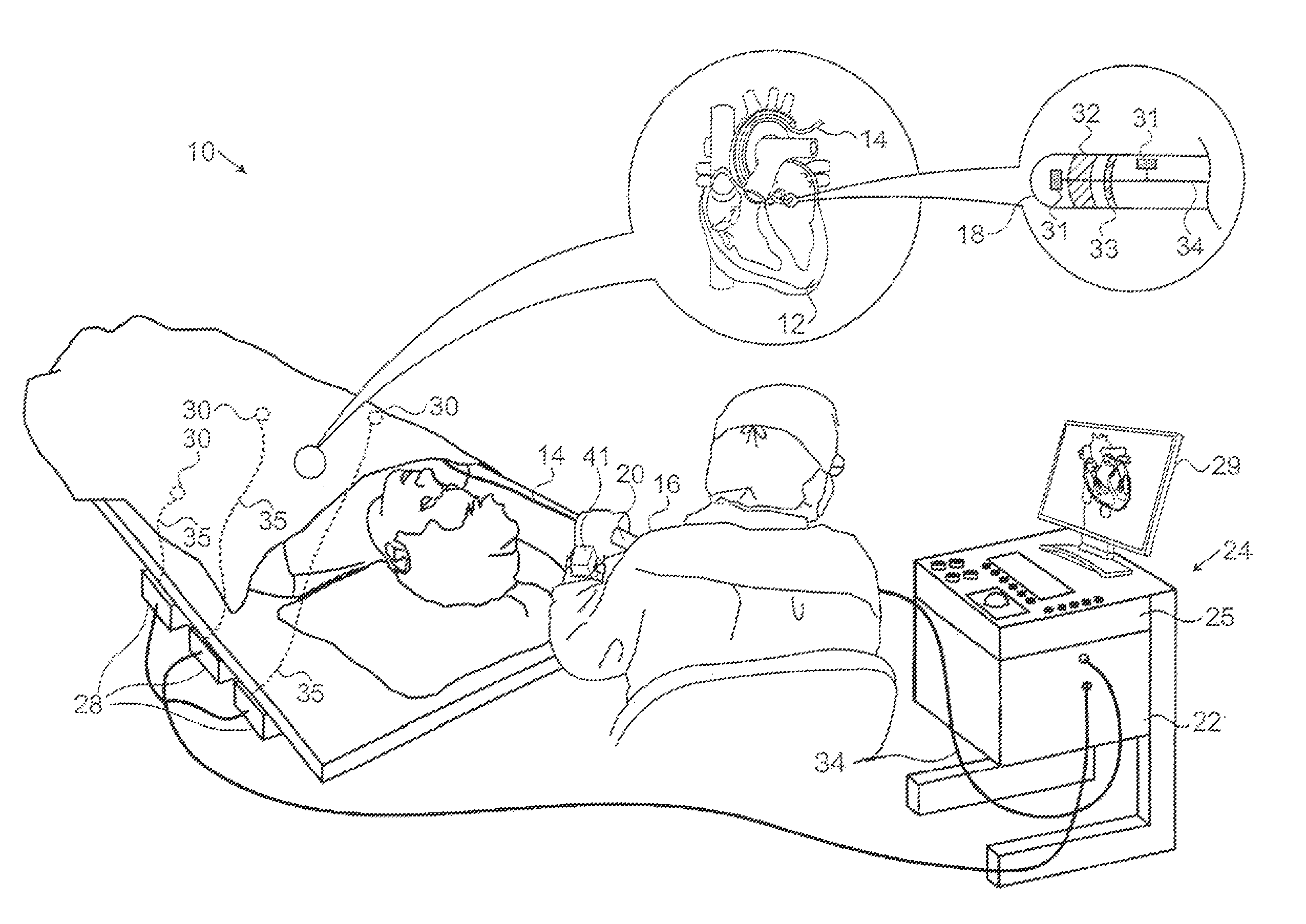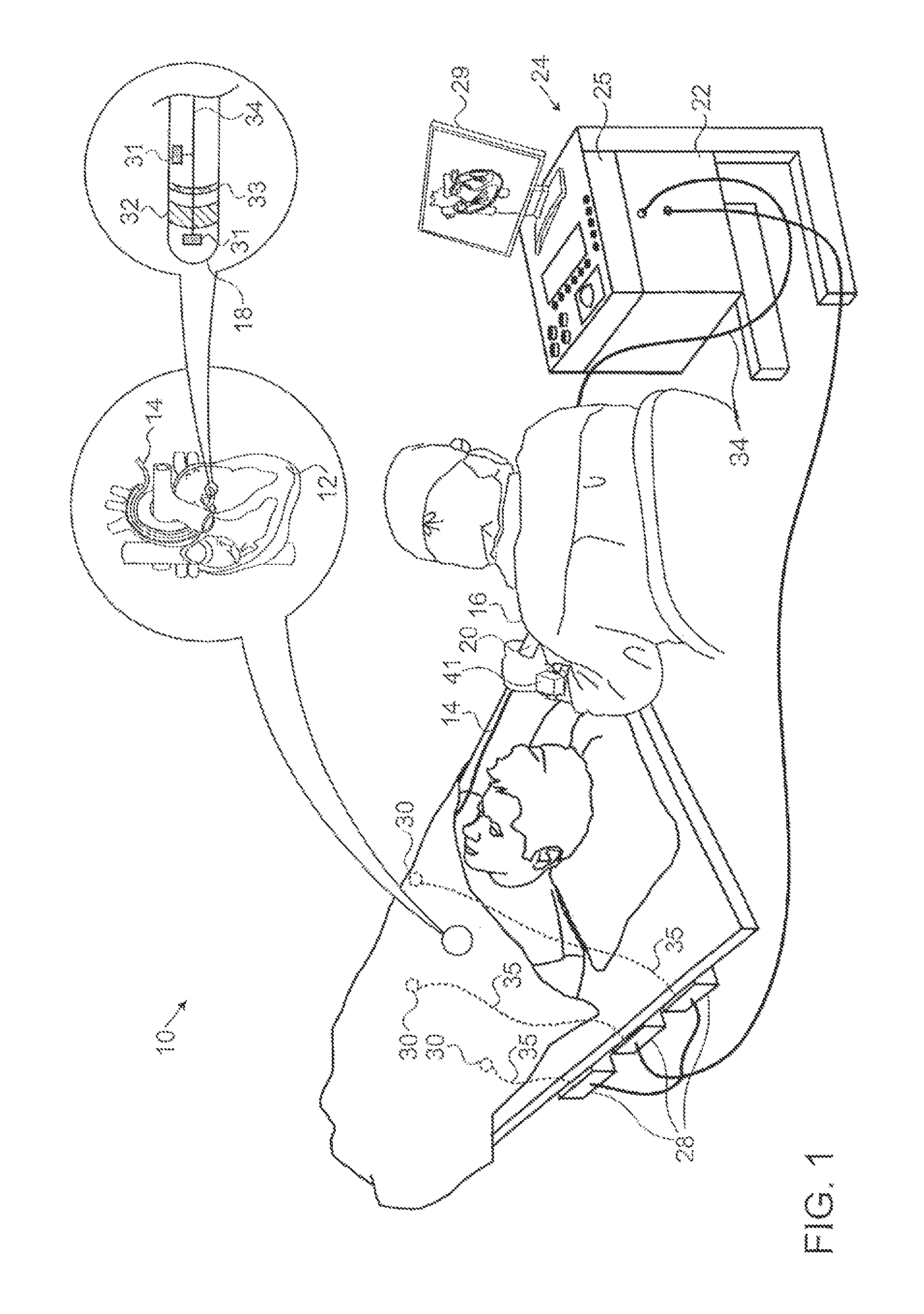Force feedback device and method for catheters
a feedback device and catheter technology, applied in the field of tissue ablation systems, can solve the problems of asynchronous rhythm and disruption of normal cardiac cycle, and achieve the effect of avoiding distraction
- Summary
- Abstract
- Description
- Claims
- Application Information
AI Technical Summary
Benefits of technology
Problems solved by technology
Method used
Image
Examples
first alternate embodiment
[0068]Reference is now made to FIG. 6, which is a schematic view of portions of a haptic device 79 being worn about a wrist 81 of an operator, in accordance with an alternate embodiment of the invention. This embodiment operates in a similar manner to the embodiment described with respect to FIG. 2-FIG. 5. However the single actuator 67 is replaced by an array of actuators 83, 85, 87, 89, 91, 93, 95, which are distributed along the length of a strap 97 that is wrapped about wrist 81. The actuators are independently controlled as described above, e.g., by multiplexing the communication channel between the communications modules 45, 47 (FIG. 2) or by providing a plurality of communication channels. The actuators 83, 85, 87, 89, 91, 93, 95 are thus capable of individually and independently applying pressure at points on the circumference of the wrist 81 or other body part. For example, in FIG. 6 the actuator 89 is active, depressing a segment 99 of the strap 97, and thus producing an e...
second alternate embodiment
[0070]Reference is now made to FIG. 7, which is a schematic view of portions of a haptic device 107 being worn about the wrist 81, in accordance with an alternate embodiment of the invention. This embodiment has components in common with the haptic device 43 (FIG. 2), but operates using hydraulic or pneumatic methods to produce a tactile effect on the wrist 81. An inflatable cuff 109 (indicated by hatching in FIG. 7) is adapted to fit about the wrist 81 (or other body part), and is expandable from a deflated configuration indicated by broken line 111 to an inflated configuration indicated by solid line 113.
[0071]Inflation and deflation are produced by the action of a displacement hydraulic motor 115, which can be bidirectional, as shown in FIG. 7, or unidirectional. The motor operates under control of the signal processor 49, as described above with respect to FIG. 2.
[0072]When the hydraulic motor 115 inflates the cuff 109 through a hydraulic line 117, the operator perceives a press...
third alternate embodiment
[0074]Reference is now made to FIG. 8, which is a schematic view of portions of a haptic device 121 being worn about the wrist 81, in accordance with an alternate embodiment of the invention. This embodiment has components in common with the haptic device 107 (FIG. 7). However a cuff 123 is partitioned into multiple cells 125, each supplied by separate hydraulic lines 127. A hydraulic motor 129 may have individually operated ports or valves as shown in FIG. 8. Alternatively, individual hydraulic motors may supply the cells 125 via respective hydraulic lines 127. In any case, the hydraulic motor 129 or motors are controlled by the signal processor 49.
[0075]This embodiment has the same enhanced abilities as the haptic device 79 (FIG. 6), which are not repeated in the interest of brevity.
PUM
 Login to View More
Login to View More Abstract
Description
Claims
Application Information
 Login to View More
Login to View More - R&D
- Intellectual Property
- Life Sciences
- Materials
- Tech Scout
- Unparalleled Data Quality
- Higher Quality Content
- 60% Fewer Hallucinations
Browse by: Latest US Patents, China's latest patents, Technical Efficacy Thesaurus, Application Domain, Technology Topic, Popular Technical Reports.
© 2025 PatSnap. All rights reserved.Legal|Privacy policy|Modern Slavery Act Transparency Statement|Sitemap|About US| Contact US: help@patsnap.com



